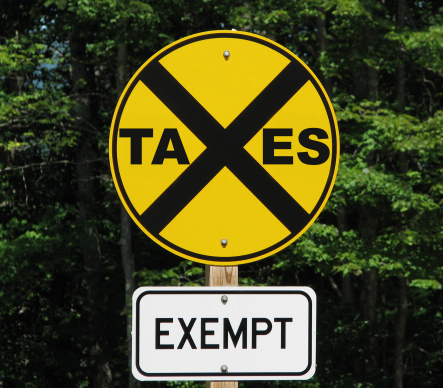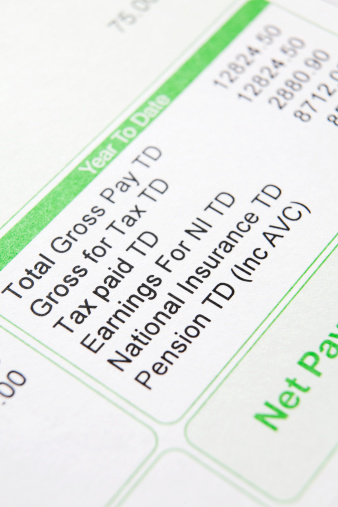Foreign Income Must be Reported
As an American citizen overseas—regardless of where you live or work—you are generally required to file a U.S. tax return, reporting any income generated abroad, in addition to your earnings on the U.S. side.
You are also subject to the same filing requirements that apply to U.S. citizens or residents living in the U.S. As long as you meet the gross income requirement, there’s no escaping the IRS.
You are also eligible for just about all of the deductions. You can choose to take the standard deduction, or itemize on Schedule A. If you itemize, you may deduct mortgage interest, property tax, investment interest, etc. The only major issue is charitable contributions made to a non-U.S. church or organization.
In order for a charitable contribution to be deductible, it must be made to an IRS approved organization. In other words, the charity must qualify under Code Section 501(c)(3). Only the largest of international charities have gone through this approval process, thus, it is unlikely that a contribution to your local non-U.S. church or group is deductible on your U.S. tax return.
Certain deductions may also be reduced by the foreign housing exclusion for the foreign earned income exclusion. However, this is rare and you will need to consult with a tax professional for further guidance.
Even if you determine that your federal tax obligation is zero, you must still complete and file the forms. The IRS changes the filing thresholds slightly each year. In general, once you have the following gross income amounts for 2012, the law requires you to file a federal tax return with the IRS:
Single . . . . . . . . . . . . . . . . . . . . . . . . . . . . . . . . . . . . . . . . . $9,500
— 65 or older . . . . . . . . . . . . . . . . . . . . . . . . . . . . . . . . . . . $10,950
Head of household . . . . . . . . . . . . . . . . . . . . . . . . . . . . . . . $12,200
— 65 or older . . . . . . . . . . . . . . . . . . . . . . . . . . . . . . . . . . . $13,650
Married filing jointly . . . . . . . . . . . . . . . . . . . . . . . . . . . . . $19,000
— One spouse 65 or older . . . . . . . . . . . . . . . . . . . . . . . . . $20,150
— Both spouses 65 or older . . . . . . . . . . . . . . . . . . . . . . . . $21,300
Married filing separately . . . . . . . . . . . . . . . . . . . . . . . . . . . $3,700
Qualifying widower . . . . . . . . . . . . . . . . . . . . . . . . . . . . . . . $15,300
— 65 or older . . . . . . . . . . . . . . . . . . . . . . . . . . . . . . . . . $16,450
To determine if you meet the gross income requirement for filing purposes, you must include all income you receive from foreign sources as well as your U.S. income.
This is true even if:
• The income is paid in foreign money.
• The foreign country imposes an income tax on that income.
• The income is excludable under the foreign earned income exclusion.
If you are self-employed, and generate more than $400 of net self-employment earnings in a single year, you must file a U.S. income tax return, regardless of your age. Net earnings from self-employment include the income earned both in a foreign country and in the U.S.
You must pay self-employment tax on your net self-employment income, even if it is earned in a foreign country and is excludable as foreign earned income in figuring your income tax. This is an important point worth repeating: the foreign earned income exclusion helps reduce the income tax—not the self-employment tax. The only way to reduce self-employment tax is with ordinary business expenses incurred in the self-employment activity or to operate the business through a foreign corporation.
The Standard Deductions for tax year 2012 are as follows:
Married, Filing Joint Return. . . . . . . . . . . . . . . . . . . . . . . . . . . . . . . . . . . . $11,900
Head of Household. . . . . . . . . . . . . . . . . . . . . . . . . . . . . . . . . . . . . ………. $8,700
Unmarried (not S.S. or H.H.) . . . . . . . . . . . . . . . . . . . . . . . . . . . . . . . . . . . . $5,950
Married, Filing Separate Return. . . . . . . . . . . . . . . . . . . . . . . . . . . . . . . . . . $5,950
Tax Advantages for Americans Overseas
The good news is that you may be able to exclude from your income some or all of your foreign earned income. Earned income includes salary, wages, and self-employment earnings. You may also be able either to exclude or to deduct from gross income a “housing amount.” And—depending on your situation—you may qualify for a foreign tax credit or deduction for the local taxes paid to a foreign country. Based on your own particular circumstances, these advantages may reduce—or sometimes eliminate—your federal tax liability.
While exclusions and credits can reduce your tax liability to Uncle Sam, the United States has concluded tax treaties—and other international agreements—with many foreign countries which may help reduce your foreign tax liability, as well.
In theory, the foreign earned income exclusion, the credit or deduction for foreign income taxes, and the application of tax treaty provisions are designed to prevent overseas Americans from paying taxes to both the U.S. and a foreign country on the same income. In other words, they are designed to avoid double taxation. If you are fortunate enough to live in a foreign country that—for one reason or another—doesn’t tax your income, and your salary while abroad is less than or equal to the foreign earned income exclusion amount, this exclusion may allow you to escape income taxes altogether
Foreign Earned Income Exclusion
The most important tool in the expat’s U.S. tax toolbox is the Foreign Earned Income Exclusion (FEIE or Exclusion). If you qualify, you can exclude up to $95,100 in 2012 of foreign earned income free from U.S. Federal income tax. If you are married, and both spouses qualify for the exclusion, your total exclusion may be $182,800.
Foreign Earned Income
As I said above, only income that is both foreign and earned can be excluded from Federal income tax. Income that is foreign is that which is earned while you are physically present outside of the United States. Income that is earned is wages, salaries, professional fees and other amounts received as compensation for personal services actually rendered when your tax home was located in a foreign country and you meet either the bona fide residence or physical presence test. Wages can come from a U.S. corporation or a foreign corporation, including an offshore corporation, and it does not matter that you are also a shareholder or owner of that corporation.
Earned Income does not include interest, dividends, or other investment or passive income.
To qualify for the exclusion, you must first prove that your “tax home” is outside of the United States. Second, you must meet the requirements of either the residency or 330 day tests.
Your tax home is where your principal place of business is located, regardless of where you maintain your residence. In most cases, if you live and work outside of the United States, your tax home is located there.
The concept of a tax home can become complicated in a few, specific instances, such as when someone works in Mexico and lives in the U.S. (ie. commutes from the U.S. to Mexico each day). In that circumstance, your tax home is the U.S. and the FEIE is not available.
In the vast majority of cases, one’s tax home is not a major consideration, therefore, I will not go in to more detail here. For more information, contact a tax professional or see Code Section 911(d)(3) and the related regulations and examples.
Once you have established that your tax home is outside of the United States, you must meet the requirements of either the 330 day test or the residency test.
1. 330 Day Test: You must be outside of the United States for 330 out of any 365 day period. It does not matter if the 330 days is over two calendar years (example: between November 1, 2011 to October 31, 2012) and a special extension to file your tax return is available to give you time to meet this requirement.
2. Bona Fide Residency Test: Residency is achieved by moving to another country and making it your “home.” You can intend to return to the United States in the future, but you must move to the foreign country for an “indefinite” or “extended” period of time, which must include one entire calendar year. This is discussed in detail below.
As you can see, the 330 day test is fact based, while the residency test turns on your intentions and is therefore more difficult to use and prove. I often recommend relying on the 330 day test in the first year you claim the Exclusion, and then moving to the residency test after applying for or gaining residency in your new home.
Also, the exclusion is computed on a daily basis. Therefore, the maximum limit must be reduced for each day during the calendar year that you do not qualify. The exclusion is also limited to the excess of your foreign earned income for the year over your foreign housing exclusion.
Bona Fide Residency Test
The bona fide residency test is one of the most misunderstood and misused sections of the tax code by those working and living abroad…especially by contractors on “temporary” assignments and those in combat zones.
You are a bona fide resident if you move to a foreign country and make it your home. You do this by filing and paying taxes in that country, moving there and planning to stay indefinitely, and generally becoming part of the local community.
The perfect example of a resident is someone who moves to a foreign country, does not intend to return to the U.S., files and pays taxes in that country, is on a long term visa that allows them to work in that country, applies for residency and/or citizenship if possible, sell their U.S. home and buys one in the foreign country, and if they are married or have children, those family members relocate with them.
The problem with the residency test is that very few cases are perfect. For example, a husband might move to France to work indefinitely, leaving his family in California, where he returns to visit for 40 days per year. He also plans on returning to California when it is financially possible. This taxpayer must use the residency test and convince the IRS that his tax home is in France, while his wife’s tax home is in the U.S. This can be a challenging tax issue.
Also, being out of the U.S. for one calendar year does not make you a resident of a foreign country. For example, if you go to a foreign country to work on a particular construction job for a specified period of time, say 14 months, you ordinarily will not be regarded as a bona fide resident of that country even though you work there for one tax year or longer. The length of your stay and the nature of your job are only some of the factors to be considered in determining whether you meet the bona fide residence test.
If the residency test is so complex, why use it? Because qualifying under this test, rather than physical presence, allows you to return to the U.S. for a few months each year rather than only 35 days. Second, once you qualify as a resident of a foreign country, you will remain a resident of that country for U.S. tax purposes until you give up your residency. With the 330 day test, you must be out of the country for 330 of each 365 day period.
Finally, with the residency test, you can qualify for all or part of a year. Here is an example:
Andy is a U.S. citizen who qualifies for the FEIE using the physical presence test by living in Costa Rica for all of 2011. He spent no days working in the United States and received $78,000 in salary. Assuming he claimed no foreign housing exclusion, Andy is able to exclude all of this salary from his gross income because it is less than the Foreign Earned Income Exclusion amount for 2011 of $92,900. Andy continues to work in Costa Rica until October 31, 2012, when his employer permanently reassigns him to the United States. During this time, Andy received a salary of $95,000 for his work in Costa Rica in 2012. Assuming he claimed no foreign housing exclusion, the maximum amount of foreign earned income he can exclude from his gross income in 2012 is $79,467 ($95,100 multiplied by ratio of the number of days he was working in Costa Rica (305/365)).
Perpetual Traveler
One major issue I see time and time again, especially with retiree’s living abroad, is the “perpetual traveler.” This is someone who is never in any one place long enough to lay down roots. They travel from place to place, possibly residing in one city for a few days, or a few months.
As stated above, the residency test is based on your intent to move to a particular place and make it your home. If you have no home base, or are not a part of any community in particular, you may not be eligible to use the residency test.
In my opinion, the perpetual traveler is forced to use the 330 day test. Therefore, they must be outside of the U.S. for 330 out of each 365 day period. This may limit the perpetual traveler’s ability to visit family or vacation in the States.
Simply gaining residency in a nation, such as Belize that only requires you to be in their country a few months each year, will not suffice for U.S. tax purposes. The residency test is based on a number of facts and circumstances, and having a residency permit is only one factor.
However, once you establish residency in one place, you will not lose that status in the U.S. tax system, until you give it up (also stated above). Therefore, if you move to a foreign country for a year or two, with the intent of making it your home, and then become a perpetual traveler, you should maintain your foreign residency status.
Travel Days
Since about 2008, it has been the IRS’s position that travel days, and time spent in international waters or airspace are not days outside of the U.S. for the purposes of the FEIE. This argument has been supported by a few U.S. tax court cases.
What does this mean to you? If you are using the 330 day test, you must count days traveling to and from the U.S., as days in the U.S., and not foreign days.
If you are in a business, such as a ship captain or airline pilot, that requires you to spend time in international waters, then you have a problem. If you have no residency, and are required to use the 330 day test, you may not be eligible for the FEIE. If this applies to you, you should contact a tax professional.
Forced Out
Relief from either the residency or the 330 day test is available if you are forced to flee a foreign country because of civil unrest, war, or other adverse conditions. To qualify, you must have been a bona fide resident of, or present in, the foreign country on or before the date the IRS determines that adverse conditions exist. In addition, you must establish that you could reasonably be expected to have satisfied the residency requirements had the adverse conditions not arisen. The IRS publishes the names of countries for which this waiver is available annually.
I note that the adverse conditions must arise after you moved to the country in question. Each year I have contractors working in war zones ask if they can use this clause to get out of their contracts and still use the FEIE. Of course, the answer is no. Anyone who travels to a country on the list is on notice and the exception is not available.
Use it or Lose It
In a perfect world, all U.S. citizens file their U.S. tax returns on April 15 and make use of all the proper exclusions and deductions. Of course, that is not the case. In fact, the majority of returns I prepare for those living abroad are delinquent.
This can be extremely costly for those using the foreign earned income exclusion. If you file late, and you are audited by the IRS, you might lose the foreign earned income exclusion, and pay tax on 100% of your foreign earned income!
Generally, a qualifying individual’s initial choice of the foreign earned income exclusion must be made with one of the following income tax returns:
- A return filed by the due date (including any extensions),
- A return amending a timely-filed return. Amended returns generally must be filed by the later of 3 years after the filing date of the original return or 2 years after the tax is paid, or
- A return filed within 1 year from the original due date of the return (determined without regard to any extensions)
An exception to this rule will be made provided that:
- You owe no federal tax after accounting for the exclusion, or
- Prior to the IRS discovering you failed to elect/utilize the exclusion.
If you owe tax after taking the FEIE into account, and the IRS discovers your failure to use the FEIE, then you may request relief by requesting a private letter ruling under Income Tax Regulation 301.9100-3 and Revenue Procedure 2009-1.
Having handled several of these cases, I can tell you that negotiating a settlement, or securing a letter ruling, will be a very costly and time consuming battle. It is possible to have about $1 million in untaxed income at issue, where a husband and wife failed to file a return for 6 or 7 tax years and would have been eligible for the full FEIE.
What if I am not overseas for a full tax year?
If during a tax year, you are overseas for only part of one tax year, but not long enough to qualify for the exclusion based on either physical presence or bona fide residence, you have four options:
1. If you paid foreign income tax, claim the foreign tax credit if it means you can avoid paying any U.S. income tax. In general, this applies when the tax rate of your foreign country is higher than, or equal to the U.S. tax rate.
(Caution: This option should be made only with the advice of a tax professional. It is not entirely clear at this time whether claiming a foreign tax credit when you could have chosen the foreign earned income exclusion will automatically revoke your election to take the exclusion for the following five years without the approval of the IRS.)
2. File your tax return for the year without claiming the exclusion. Then, once the physical presence or bona fide residence qualifying period is reached in the following year, you can file an amended return to claim a pro-rated exclusion for the part-year.
3. Those who were overseas for the last three months of the year (let’s say in 2010 for this example) and expect to be overseas for the first nine months of the following year, can file an IRS Form 4868 and if necessary the applicable state return filing extension request for automatic extensions to October 15. This will allow time to meet the 12 month physical presence test before the extended due dates of the returns. Once the 12 month period is reached, the 2010 tax returns can be filed claiming the partial exclusion for the time spent overseas in 2010.
4. File a Form 2350—a further application for extension of time to file beyond October 15. This allows you sufficient time to qualify under either of the two time requirements, plus 30 days to file the return for the year in which you qualified for only the part-year exclusion. In choosing your strategy, you need to consider the consequences involved. If financial concerns are paramount, then you should seek advice from a tax professional. If you have a considerable amount to pay on the original return—most of which you will recover on an amended return—you may prefer to wait out the qualification period and file one return.
HOUSING EXCLUSION OR DEDUCTION
If your tax home is in a foreign country—and you meet either the bona fide residence test or the physical presence test—you may be able to claim an exclusion or deduction from gross income for housing provided by your employer. Employees claim an exclusion, whereas a deduction is claimed by those who are self-employed.
For the exclusion, foreign housing is provided by an employer if any amount is paid or incurred by the employer on your behalf and included in your foreign earned income (for example, housing allowance or reimbursement).
A housing amount is determined as the excess, if any, of your allowable housing expenses for the tax year over a base amount which increases each year. For 2012 the qualifying daily rate is $36.47 or $13,314 for an entire year of qualifying days (this is 16% of the total FEIE). Allowable housing expenses are the “reasonable” expenses incurred by you and your family such as:
- Rent paid on your foreign property.
- Utility charges incurred (other than telephone charges).
- Real and personal property insurance for foreign housing.
Items that are not considered “allowable housing expenses” include:
-
- The cost of home purchase or other capital items.
- Wages of domestic servants.(Note: Under certain circumstances, such wages may qualify as “childcare expenses.”)
- Deductible interest and taxes.
You can also include the allowable housing expenses of a second foreign household for your spouse and dependents if they did not live with you because of adverse living conditions at your tax home.
The base amount is figured on a daily basis. Your allowable housing amount is the IRS-determined base amount times the number of days during the year that you meet the bona fide residence or physical presence test. The base amount, which changes each year, is shown on each year’s Form 2555. It is found on line 32 of the Form 2555 for 2011.
Determining your housing
You can exclude or deduct (within the lower and upper limits) your entire housing amount from income if it is considered paid for with employer-provided amounts. Employer-provided amounts are any amounts paid to you—or on your behalf—by your employer, including salary, housing reimbursements, and the fair market value of pay given in the form of goods and services.
If you have no self-employment income, your entire housing amount is considered paid for with employer-provided amounts. If you claim the exclusion, you cannot claim any credits or deductions related to excluded income, including a credit or deduction for any foreign income tax paid on the excluded income.
If you are self-employed—and your housing amount is not provided by an employer—you can deduct the housing amount to arrive at your adjusted gross income.
However, the deduction cannot be more than your foreign earned income for the tax year, minus the total of your excluded foreign earned income and the foreign housing deduction amounts.
If you are an overseas employee who also carries on an overseas self-employment activity, the rules are more complicated. To determine the net self-employment income for both income and self-employment tax purposes, you should consult a tax professional.
Second foreign household
Ordinarily, if you maintain two foreign households, your reasonable foreign housing expenses include only costs for the household that bears the closer relationship (not necessarily geographic) to your tax home. However, if you maintain a second, separate household outside the United States for your spouse or dependents because living conditions near your tax home are dangerous, unhealthful, or otherwise adverse, include the expenses for the second household in your reasonable foreign housing expenses.
You cannot include expenses for more than one second foreign household at the same time. If you maintain two households and you exclude the value of one because it is provided by your employer, you can still include the expenses for the second household in figuring a foreign housing exclusion or deduction.
Adverse living conditions include:
- A state of warfare or civil insurrection in the general area of your tax home.
- Conditions under which it is not feasible to provide family housing—for example, if you must live on a construction site or drilling rig.
WHAT EXCLUSION WILL I TAKE?
You make separate choices to exclude foreign earned income and/or to exclude or deduct your foreign housing amount. If you choose to take both the foreign housing exclusion and the foreign earned income exclusion, you must figure your foreign housing exclusion first.
Your foreign earned income exclusion is then limited to the smaller of (a) your annual exclusion limit, or (b) the excess of your foreign earned income over your foreign housing exclusion. This limitation is automatically computed on the Form 2555.
It is often difficult to follow the interplay of the lines on tax forms because forms are generally designed by mathematicians whereas the rules are most often written by lawyers. A simpler way of looking at it is that your combined earned income exclusion and housing exclusion cannot exceed your total overseas earnings.
Once you choose to exclude your foreign earned income and/or housing amount, that choice remains in effect for that year and all future years unless you revoke it. You can revoke your choice for any tax year. However, if you revoke your choice in one tax year, you cannot claim the exclusion again for your next five tax years without the approval of the IRS. For more information on revoking the exclusion, see (1) Effect of Choosing the Exclusion and (2) Revoking the Exclusion, both of which are found on page 20 of the 2012 Publication 54.
After reading these two sections, you may reach the conclusion that simply taking a foreign tax credit when you could have chosen the exclusion will automatically disqualify you from claiming the exclusion for the next five years without the approval of the IRS.
If, in your case, a foreign tax credit would be far more beneficial than claiming the exclusion, you should discuss your situation with a tax professional.
For a consultation, you can reach a us at (619) 483-1708 or by email to info@premieroffshore.com.
FORM 2555 OR FORM 2555EZ?
The Form 2555EZ is a shorter, simpler version of the Form 2555 but may be used only if you meet all of the following requirements:
- Total foreign earned income is $91,400 or less.
- The return being filed is for a full calendar year.
- You have no self-employment income.
- You have no business or moving expenses.
- You are not claiming the foreign housing exclusion or deduction.
There is no need to memorize the above conditions. They are printed on the top of page one of the Form 2555EZ.
MARRIED COUPLES CLAIMING EXCLUSIONS
If both you and your spouse are eligible for either the foreign earned income or housing exclusion, you can file separate Form 2555s (or 2555EZs) and claim separate exclusion amounts. For further details on married couples filing separate 2555s, see Chapter Four of Publication 54.
If you are married and residing either in a foreign country with community property laws or a domiciliary of a U.S state with community property laws, you need to consult a tax expert.
WAIVER OF TIME REQUIREMENTS
Disruption of the qualifying time period because of war, civil unrest, or similar adverse conditions in the foreign country would not preclude you from claiming at least part of the exclusion. However, there are special rules to determining a reduced amount of the exclusion. Here again, you should refer to Publication 593 or Publication 54, or consult with a tax professional.
EXCLUSION OF EMPLOYER – PROVIDED MEALS AND LODGING
If your work requires you to live in a camp in a foreign country that is provided by or for your employer, you can exclude the value of any meals and lodging furnished to you, your spouse, and your dependents. For more details, see Publication 593 or Publication 54.
Withholding income tax and social security tax
If you are an employee of a U.S. company overseas, your employer may withhold income and social security taxes from your pay. In certain circumstances, it may be to your advantage to have your employer discontinue withholding income tax from all or part of your wages. You might do this if you expect to qualify for the income exclusions under either the bona fide residence test or the physical presence test. See Publication 54 for more information on withholding income tax.
See the U.S. security taxes section below for the requirements for employer withholding of social security taxes.
If a U.S. employer does not withhold income taxes from your foreign wages—or if not enough tax is withheld—you may have to pay estimated tax. Your estimated tax is the total of your estimated income tax and self-employment tax for the year, minus your expected withholding for the year.
When estimating gross income, do not include the income that you expect to exclude. In figuring your estimated tax liability, you can subtract from income your estimated housing exclusion or deduction. However, if the actual exclusion or deduction is less than you expected, you may be subject to a penalty for underpayment. You can use Form 1040-ES (Estimated Tax for Individuals) to estimate your tax due for the year. The requirements for filing and paying estimated tax are generally the same as those you would follow if you were in the U.S.
WITHHOLDING FROM PENSION PAYMENTS
U.S. payers of benefits from employer deferred compensation plans (such as employer pensions, annuities, or profit-sharing plans), individual retirement plans, and commercial annuities are generally required to withhold income tax from these payments or distributions. This will apply unless you choose an exemption from withholding.
To qualify for this withholding exemption, you must provide the payer of the benefits with a residence address in the U.S. (or U.S. possession), or certify to the payer that you are not a U.S. citizen, resident alien, or someone who left the United States with the principal purpose of avoiding U.S tax.
For rules that apply to non-periodic distributions from qualified employer plans and tax-sheltered annuity plans, refer to Publication 575 (“Pension and Annuity Income”).
Although the U.S. Social Security Administration (SSA) is not required to withhold federal income tax on benefit payments to American recipients residing in the U.S. or overseas, benefit recipients may request voluntary income tax withholding. Based on rules too complicated to discuss here, some of the benefit payments may be subject to U.S. income tax and the recipients may prefer to have the income tax withheld. You should check with a tax expert to determine if any of your benefit payments will be subject to U.S. income tax and whether or not it is advisable to have the tax withheld by the SSA.
Note: Some foreign countries may tax your benefit payments in spite of the fact the payments are also subject to U.S. tax. Although the many U.S. income tax treaties provide for taxation of certain income by the U.S. alone, you will need to be familiar with the laws of the foreign country in which you reside.
U.S. SOCIAL SECURITY TAXES
Under certain circumstances, you may be required to pay social security taxes to both the U.S. and a foreign country on the same income. For example, when Bob, an employee of a U.S. company, moves overseas on a foreign assignment, the employer is liable for the employer’s share and Bob is liable for his share of U.S. social security taxes on his wages. At the same time, the foreign tax laws may require that Bob’s employer pay the foreign social security taxes on the wages paid to Bob while he is living in that country.
Unless certain arrangements are made with the SSA, the same situation would occur if the U.S. company assigns Bob to work for a foreign subsidiary of which the American company is a principal owner.
The SSA is responsible for administering “totalization agreements,” which are similar to the U.S. tax treaties.
At time of writing, the U.S. has totalization agreements with the following nations: Australia, Austria, Belgium, Canada, Chile, Finland, France, Germany, Greece, Ireland, Italy, Japan, Korea (South), Luxembourg, Netherlands, Norway, Portugal, Spain, Sweden, Switzerland, and the United Kingdom.
An agreement is under discussion with Poland. Agreements with the Czech Republic, Denmark, and Mexico have been signed but have not yet come into force. (See Appendix C for full details.)
On the other hand, if you have the option of working overseas for employers other than U.S. companies—or principally owned foreign subsidiaries of U.S. companies—you will avoid any double taxation on the social security side because you will no longer be liable for the U.S. social security taxes.
If you or your employer needs more information, contact the Social Security Administration online at www.ssa.gov. Its welcome page has a “Contact Us” link that provides a variety of means of getting in touch with a representative.
Credits and Deductions on Foreign Income Taxes
In filing your U.S. returns, you can take either a credit or a deduction for income taxes imposed on you by a foreign country. Taken as a deduction, foreign income taxes reduce your taxable income. Taken as a credit, foreign income taxes reduce your tax liability.
There is no rule to determine which approach is better. Generally, it is to your advantage to take the credit, which is subtracted directly from your U.S. tax liability. Your credit cannot be more than the part of your U.S. income tax liability allocable to taxable foreign income. In other words, if you have no U.S. income tax liability, or if all your foreign income is excludable, you will not be able to claim a foreign tax credit.
If foreign income taxes were imposed at a high rate, and the proportion of foreign income to U.S. income is small, a lower final tax may result from taking the foreign income tax deduction. You must treat all foreign income taxes in the same way—you generally cannot deduct some taxes and take a credit for others.
If you choose to credit foreign taxes against your tax liability, you will need to complete Form 1116 (unless you meet the requirements outlined below), and attach it to your U.S. income tax return.
Caution: Do not include the foreign taxes paid or accrued as withheld taxes on the second page of the 2012 Form 1040 at line 63.
If the foreign taxes you paid or incurred during the year exceed the limit on your credit for the current year, you can carry back the unused foreign taxes as credits to the two previous tax years, and then carry forward any remaining unused foreign taxes to the next five tax years.
You will not be subject to this limit, and may be able to claim the credit without using Form 1116, if the following requirements are met:
- You are filing as an individual.
- Your only foreign source income for the tax year is passive income coming from sources such as dividends, interest, and royalties, which are reported to you on a payee statement such as a Form 1099-DIV or 1099-INT.
- Your qualified foreign taxes for the tax year are not more than $300 ($600 if filing a joint return) and are reported on a payee statement.
- You elect this procedure for the tax year. (If you make this election, you cannot carry back or carry over any unused foreign tax to or from this tax year.)
If you choose to deduct all foreign income taxes on your U.S. income tax return, you need to itemize the deduction on Form 1040 Schedule A.
The foreign tax credit and deduction, their limits, and the carry back and carry over provisions are discussed in detail in IRS Publication 514.
Foreign Currency: The foreign income, expenses, and credits must be converted from foreign currency using an appropriate exchange rate and reported on the U.S. return in U.S. dollars.
CLAIMING A DEDUCTION FOR RELOCATION EXPENSES
If you incur expenses when relocating overseas, you may qualify for a deduction of “reasonable” moving expenses. Keep in mind that moving expenses relate to the income earned after the move and you cannot claim expenses attributed to excluded income. For example, if you are an employee and move overseas, your unreimbursed moving expenses are generally deductible. However, if you are able to exclude all of your overseas earnings in the year of the move, the following year you cannot claim any of the unreimbursed moving expenses regardless of whether or not they are reasonable. See Publication 54 for more details.
AVOIDING DOUBLE TAXATION
If you have paid foreign taxes on the earnings that qualify for the earned income exclusion, you will have to make a choice of taking the exclusion, taking the tax credit/deduction, or taking a combination of the two.
A good tax software program should allow you to prepare a complete return claiming the income exclusion, housing exclusion/deduction, and the foreign tax credit. Once the return is prepared, the program should allow you to easily produce two duplicate computer copies. These can be produced individually using the other two options for comparison to figure out which option produces the best results. As mentioned earlier, you need to do the math.
If you claim the exclusion, you cannot claim any credits or deductions that are related to the excluded income—the concept being that you can’t get a double benefit. Nor can you claim the earned income credit, which is to benefit low income earners. In other words, someone who earned $100,000 overseas and excluded $91,400 is not the same as an individual whose total earnings are only $8,600.
Also, for Individual Retirement Account (IRA) purposes, the excluded income is not considered compensation and, for figuring deductible contributions when you are covered by an employer retirement plan, the excluded income is included in your modified adjusted gross income.
DOUBLE TAXATION TREATIES
If a “double taxation” treaty exists between the United States and the country in which a U.S. citizen resides, then the tax treaty supersedes the Internal Revenue Code (IRC), and the language of the treaty governs. As a general rule, tax treaties allow you to offset foreign tax paid against what your federal tax liability would have been.
This means that if your foreign taxes are higher than your U.S. federal tax, no U.S. tax is due. If your foreign taxes are lower, then the difference would generally still be due to Uncle Sam, unless it was exempted under the rules for foreign earned income exclusion.
Treaties generally provide U.S. students, teachers, and trainees with special exemptions from the foreign treaty country’s income tax.
Publication 901 contains detailed information on tax treaties and tells you where you can get copies of them. Click here for additional information: http://www.irs.gov/publications/p901/index.html
Foreign Bank Accounts Must be Reported
If you had any financial interest in, or signature or other authority over a bank account, securities account, or other financial account in a foreign country at any time during the tax year, you may have to complete Form 90-22.1 and file it with the Department of the Treasury. You need not file this form if the combined assets in the account(s) are $10,000 or less during the entire year, or if the assets are with a U.S. military banking facility operated by a U.S. financial institution. The deadline for filing is June 30 of each calendar year.
There are no extensions and an extension to file the federal income tax return does not extend the deadline for filing the Form 90-22.1. If you have a foreign account, you must also file a Form 1040 Schedule B and complete Part III regarding foreign bank accounts—regardless of whether you are required to file a Form 90-22.1, or have any interest or dividend income to report on the Schedule B.
This requirement to report your foreign bank account is one of the most important obligations you have as a U.S. citizen living abroad. The law imposes a civil penalty for not disclosing an offshore bank account or offshore credit card up to $25,000 or the greatest of 50% of the balance in the account at the time of the violation or $100,000. Criminal penalties for willful failure to file an FBAR can also apply in certain situations. Note that these penalties can be imposed for each year.
In addition to the FBAR penalties above, intentionally failing to check the box on Schedule B to report a foreign account is a Felony. It is possible for a single violation to result in 6 to 12 months in prison!
I have personally handled many FBAR and Schedule B related cases and can tell you with certainly that the IRS is very aggressive in prosecuting these matters. For example, in one case in 2010 a client plead guilty to a single count of failing to check the box on Schedule B, and was given 6 months of confinement. In addition to the criminal case, the IRS initiated a civil audit which, when taxes, fines, interest and penalties were calculated, the client was wiped out financially. Finally, to add insult to injury, the State of California came in with their taxes, interest, and penalties.
The Schedule B rules and the FBAR are no joke, and they are not just used against money launders and drug dealers. Prosecutions and civil fines have become a major revenue sources for the IRS.
Filing Deadlines, Extensions, and Penalties
If your tax year is the calendar year, the due date for filing your income tax return is April 15 of the following year—unless that date falls on a weekend day or holiday, which would allow you an additional day or two.
AUTOMATIC TWO – MONTH EXTENSION FOR AMERICANS
The good news is that overseas Americans are automatically granted a two-month extension to June 15 to file (and pay their tax).You don’t have to request this extension in advance. When the time comes to file, simply attach a statement to your return explaining that you were either:
1) Living outside the U.S. and Puerto Rico and that your main place of business or post of duty was outside the U.S. and Puerto Rico; or
2) In the military or naval service on duty outside the U.S. or Puerto Rico.
Note: If you are filing electronically (I’ll discuss this later), you will need to check your software instructions or check with your software provider on how to electronically file the extension form or to add the required statement to the return.
What to do if you need more time
Better still is the Form 4868 (“Application for Automatic Extension of Time to File U.S. Individual Income Tax Return”). This form will get you a full six-month extension.
No signature and no reason will be required for the six-month extension to October 15 (or the alternate date under the weekend and holiday rule).
TIME TO PAY TAX DUE ON A RETURN
With the exception of the automatic two-month extension for overseas Americans, an extension of time to file does not mean an extension of time to pay the tax. Although you will be required to pay interest on any payment made after April 15, you will not be required to pay the late payment penalty (see below) for the period April 15 to June 15.
WHERE TO FILE
If you claim the foreign earned income exclusion or the foreign housing exclusion or deduction on a paper tax return, you should file your return with the Internal Revenue Service, Austin, Texas 73301-0215.
Electronic filing has its own set of filing rules that are not treated here. A good software program with the electronic filing feature allows you to send the federal and, if applicable, the state income tax return to the relevant processing center.
ELECTRONIC FILINGS IS THE WAY TO GO
If you have the option, paperless filing is the way to go. All you need is a computer, tax preparation software with the electronic filing feature, and Internet access. You complete your return (and with some software programs the Form 4868 as well), send it over the wires, and await confirmation from the IRS or a state tax department that your return was accepted. If rejected, you should receive an error message that either tells how to correct the error(s) for resubmission or a statement of why the return cannot be accepted for electronic filing. The deadline for electronic filing is April 15, or October 15 (or the alternate date under the weekend and holiday rule) if you file an extension. You may not file a late return electronically.
The rules that relate to formatting, what information must be included on the return, and what forms or schedules if included in the return forms will disqualify the return from electronic filing, are mind-boggling. However, as with any good software program, the computer does most of the analytical work. And, if you mess up, the programs are generally designed to alert you to your mistakes or provide other reminders to help you through the process.
Most software programs allow you to complete the state tax return along with the federal return, saving time spent on duplicating data entries. The state return in most cases is produced automatically as an offshoot of the 1040. Part-year return (or even a non-resident return), if your situation warrants one, takes a little extra time because there are additional data entry steps. You will be required to allocate the annual income taxable on the federal return to the lesser amount taxable by a state for part-year residency or non-residency.
An additional benefit of tax preparation software is that, once you go through the process for the first year, most of the routine—and often tedious—data entries that apply year after year are carried forward to save you time in future years.
You’ll find a variety of good tax preparation software programs on the market. Two of the most popular are TurboTax and TaxCut.
I’d recommend that you do some research on the Internet to compare prices and availability. And make sure that whichever software program you purchase has the electronic filing capability. There are also some companies offering to prepare your taxes online, through their website, without your downloading and installing their programs. These include Intuit and H&R Block.
FOREIGN POST MARKS AND ELECTRONIC FILING
Generally, the IRS treats payments made—and tax returns filed—as received by the IRS on the date they are received by the U.S. Postal Service or a domestic courier service. Penalties could be applied by the IRS on late payments and, if applicable, late filed returns under certain circumstances including those received from overseas.
Consult a tax professional if sending tax documents from countries whose mail or courier systems are subject to lengthy delays. You should keep in mind that electronic filing is one means of avoiding mailing delays and possible penalties resulting from such delays. I generally recommend the electronic filing method to my clients overseas.
INTEREST AND PENALTIES
If you are late in filing your taxes, avoid filing altogether, or underpay taxes—whether intentionally or unintentionally—the IRS may impose a penalty. If the 1040 has no tax due, there are generally no penalties whether you filed or did not file.
Even if there are penalties, the IRS may waive them if the delay is due to “reasonable cause.” The IRS doesn’t like to pin itself down by trying to define the term reasonable cause—you have to write in with an explanation and hope for the best! The instructions for requesting elimination of a penalty for reasonable cause are found in Notice 433 on the IRS website.
The two more common penalties are the late filing and the late payment penalties. The penalty for late filing (or failing to file) a tax return is a percentage of the tax due but unpaid, unless the reason for the late filing or failure to file is due to reasonable cause. The penalty is 5% of the underpayment per month, or any part of the month, up to the maximum of 25%. If the return is not filed within 60 days of the due date (considering extensions), there is a minimum penalty which is the lesser of $100 or the tax due on the return. There is an interaction of the late filing penalty and the late payment penalty discussed below.
The late payment penalty is 0.5% for each month, or any part of a month, the tax due on a return remains unpaid. The maximum penalty is 25%.
The interaction between these two penalties in effect limits both penalties combined to the 25% maximum. For each month that both penalties apply, the late filing penalty is reduced to 4.5%.
Consequently, a return filed four months and one day late is subject to the late filing penalty of 4.5% times 5 (22.5%), and a late payment penalty of 0.5% times 5 (2.5%), for a total of 25% (the maximum).
However, if the return is filed on time but there is tax due, the late payment penalty is 0.5 per month of any fraction thereof until paid. These penalties are in addition to the interest charged for unpaid taxes. The IRS is required to determine the interest rate quarterly. For the latest information on interest rates, check with the IRS or a tax professional.
U.S. State Taxation of Foreign Income
If you have a choice of where to live and work overseas, it is important to understand how your last state of residency, the U.S., and your new home country will tax your income. High state or foreign tax rates, or lack of tax exemptions for income earned inside and outside of a new home country, can easily negate any tax advantages provided to overseas Americans under the U.S. federal tax laws.
Before we delve into state income taxes, it is important to understand the distinction between residency and domicile—although most states use these terms interchangeably. For tax purposes, your residence is generally where you currently live and work. Your domicile on the other hand may be the place you presently live, or previously lived and have a definite intention to return after living elsewhere.
Your domicile may also be a state in which you formerly lived, but failed to fulfill the conditions to abandon domicile when you moved elsewhere. For most of us, we are residents and domicile of the same state regardless of whether that state is a U.S. state or a foreign country.
Residence and domicile are important distinctions for those states that subject both their residents and their domiciliaries to state income tax. For example you may have moved to another state and established residency in that new state, but still have to file tax returns in your former state (where you are officially domiciled).
DIFFERENT STATES…DIFFERENTS RULES
Liability for state income taxes is a complicated matter. There are 51 jurisdictions including the 50 states and the District of Columbia and consequently 51 different sets of rules.
If you move from one of the more popular non-taxing states such as Florida and Texas, you needn’t ordinarily worry about liability for state income taxes while living overseas.
Other states such as Oregon, New York, and Missouri to name a few will not tax an individual who is otherwise considered a domiciliary of the state, but maintains a permanent residence elsewhere (in the U.S. or overseas) and spends less than 30 days a year in the state. Also, New Hampshire and Tennessee only tax interest and dividend income.
Then there are those states desperate for money, like California. This state has no foreign earned income exclusion, is aggressive in determining “residency” for those abroad, and, when one spouse is abroad and one is in California, this state will tax the international spouse’s income under a “community property” argument. If you live in an aggressive state, and you can first move to a non-taxing state, and then move abroad, I strongly recommend you do so.
Finding a complete listing of states who do not tax domiciliaries living outside the state is beyond the purpose of this guide. A good starting point is a very comprehensive website for finding all kinds of information on taxation. Try www.taxsites.com and click on “state links” in the tax column to check out your state of interest.
Don’t be misled by the advice that you can make a quick trip to one of the non-taxing states, set up a local address, get a driver’s license, and register to vote thereby establishing residency and domicile in that state. It doesn’t work that way. The fact that many have done exactly that without being questioned is a matter of inadequate enforcement by state tax authorities, rather than a good faith compliance with the rules for establishing and abandoning state residency.
If you think you may be taxed by a former state as a domiciliary, you need to be aware of what elements that state will look at to determine your liability for its income taxes. Some of the most important are as follows:
- Where you live.
- Where and how you vote.
- What state driver’s license you carry.
- Where your bank accounts are located.
- The location of any real property you own.
- Where your family is living if not with you.
- Whether or not you have a fixed intention of returning to a particular state if you are living elsewhere at the present time.
There is no magic formula for determining what combination of the above listed items will prompt your former state to subject your income to taxation. Some combinations are more important than others. Where you live; whether you vote in national but not state elections; which driver’s license you carry; and where your real property (if any) is located are often very critical elements. However, the most important and critical is the final point. A fixed intention to return to a particular state will always subject you to that state’s income taxes, in those states that tax as residents not only those who physically reside within the state but also its domiciliaries.
WHAT IF I DON’T KNOW WHICH U.S. STATE I WILL RETURN TO?
Unlike in foreign countries, there is no such thing as a national U.S. residency or domicile. Residency and domicile apply to states only. So, if you don’t have the fixed or definite intention to return to a particular state, but do have a fixed or definite intention to return to the U.S., you may still be able to abandon domicile in a particular state.
This is an important distinction when it comes to voting in U.S. elections. However, the Overseas Citizens Voting Rights Act allows U.S. citizens living outside the country who are presently not residents or domiciliaries of any U.S. state to vote in the federal elections (see U.S. Code 42, 1973ff).
To obtain the specific instructions and to download the form to request an absentee ballot, go to www.fvap.gov. On the opening web page you will see a large white block with the heading The Basic Absentee Voting Process. Just follow the simple instructions.












